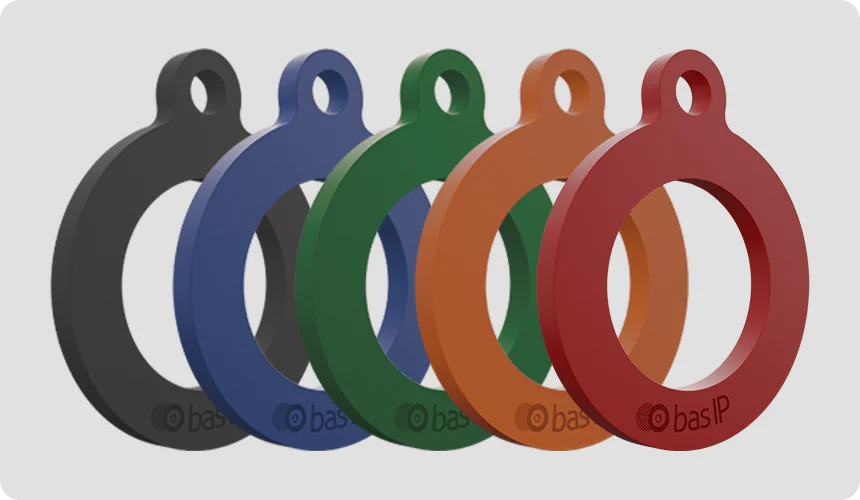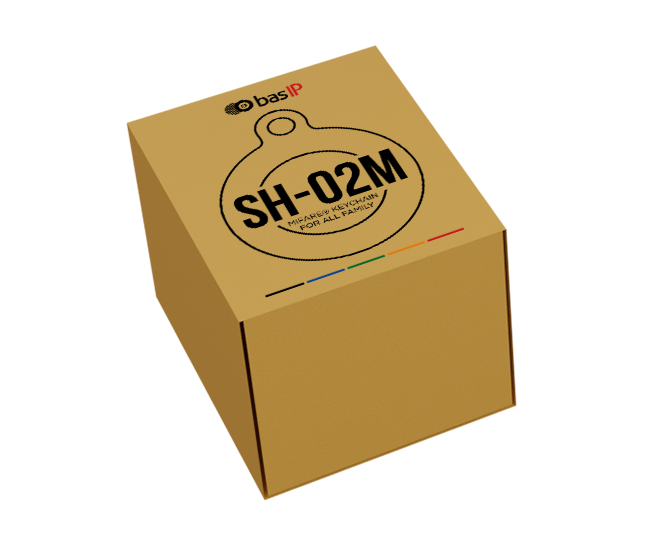Key Card & Key Fob Systems: Buyer’s Guide to Fob Access Control
In the 21st century, almost every hotel is equipped with a key card. You have probably encountered key cards in a hotel, office, or shopping mall. Offices actively use the key card, as well as it is a popular device used to enter the apartment. Key cards have been popular for a long time and are an essential component of electronic access control systems. In addition, key cards are an excellent substitute for the traditional lock and key.

This post covers:
- What are key cards and key fobs?
- How much does a key fob entry system cost?
- Types of key fobs and key cards.
- Principle of operation of the system with key fobs.
- Should you purchase an access control system with a key card or key fob?
- Alternatives to key card and fob entry systems?
What are key cards and key fobs?
Key card and key fob systems are a method of electronic access control used to control access to and from buildings. Key fobs and key cards are devices by which authorized occupants unlock doors. It is one of the most popular keyless access systems used in businesses, apartments, industrial facilities, and other types of buildings.
Three components that are needed for key card systems to function:
- Access credentials. This is essentially the credential by which the system identifies the authorized user. These small electronic devices are very effective, and they have a built-in chip or sensor that communicates with the access reader.
- Access reader. The reader acts as a scanner that performs identity verification. It works like this. The resident holds a key card up to the reader, and the reader performs an identity check. If the identification is successful, the access reader transmits a signal to the electric lock, which opens the door.
- Magnetic or electric door locks. Magnetic or electric door locks are used for electronic access control systems. The electronic lock receives “approval” from the access reader and unlocks the door, allowing the occupant to enter.
How much does a key fob entry system cost?
The cost of fob entry systems varies greatly depending on the manufacturer, the number of features, the technology used in the fob system, the number of entrances that need to be protected, and the level of protection of the system itself against hacking. The average price ranges from $1200 to $2500.
Don’t forget, however, that this amount only includes the pre-installation. If the system is used in an apartment building, you will need to purchase key fobs because some tenants often lose their key fobs or move out. Each key fob will cost you from $50 to $400 per key fob (programming time and the cost of the equipment itself are taken into account).
Types of key fobs and key cards
There are many types of key card systems. Each system has its significant differences because it uses different technology to transmit signals and user identification. Let’s go over the four most popular types.
Four popular types of key cards and key fobs:
- Wiegand keychain cards
- Swipe cards
- RFID key fobs and cards
- Proximity cards
Wiegand key cards
Wiegand is a wired communication interface between an ID reader (reader) and a controller. It is designed to transmit a unique card code or pin code to the ACS controller from the keypad.
The principle of data transmission over the Wiegand interface
Wiegand uses a three-wire bus to connect the controller and the reader ACS interface. One of the wires is designed to provide power to the reader.
The other two are called Data0 and Data1 and are used directly for information transfer. Short pulses perform transmission in a one-way pattern. The wires Data0 and Data1 are initially live. A brief voltage drop on one of them allows fixing 0 or 1, respectively.
Voltage magnitude, voltage drop time, and the interval between pulses vary depending on the controller’s parameters. In addition to the physical transmission of data, this data format is of great importance, which the presence of a Facility code can identify.
Swipe key cards
A magnetic stripe card is a type of card on which data can be stored by changing the magnetism of tiny iron-based magnetic particles on a strip of magnetic material on the card. The magnetic strip, sometimes called a card reader or magnetic strip, is read by passing it past a magnetic reader head. Magnetic stripe cards are commonly used in ID cards and transportation tickets.
Swipe cards differ from Wiegand cards because they are manufactured and encoded differently. In contrast to Wiegand cards, swipe key cards can be wiped and rewritten to interact with a different reader or lock.
RFID keychains and cards
RFID (Radio Frequency Identification) is a method of automatically identifying objects in which data stored in so-called transponders, or RFID tags, is read or written through radio signals. Any RFID system consists of a reader (reader, reader, or interrogator) and a transponder. The basis of a transponder system is radio waves.
This is how the system works:
- An RFID keychain sends a signal to a reader. The RFID card readers emit an excitation field. The key fob must be in close proximity to the radiated electromagnetic field to open the door.
- The reader then sends the signal back to the key fob. It also works the other way around: The reader sends the call to the key fob, then the key fob sends the signal back to the reader. The door opens if the key fob sends the correct data to the reader.
- Most access control systems consist of a separate reader. It is installed next to the door to select RFID door locks. These types of locks have built-in RFID readers.
Proximity cards
The working principle of proximity cards (Proximity Cards) is very similar to RFID keys. Proximity cards also use radio waves to communicate with the reader. However, this system has several differences. Proximity systems require the user to be directly next to the reader. Contactless systems also use a different radio frequency.
Active and passive readers. What is the difference?
The difference between an active and passive proximity reader is not great, but there are some crucial differences. Passive and active proximity readers require power, but they receive it differently. The engaged reader has a built-in battery, while the passive reader gets its power from the electric field emitted by the card readers in the immediate vicinity.
Principle of operation of the system with key fobs
The basis of entry systems operation is wireless signals. These signals allow cards and fobs to communicate with the access reader. The reader unlocks the doors when the key fob card provides the correct data.
Here’s how to use the key fob system:
For the reader to recognize your key fob as authentic, you must first bring your key fob to the access reader or swipe your key card across the reader, similarly with a contactless RFID key fob. The reader will then check the credentials and determine whether the key fob is authentic. As you have already understood, there are different readers and different ways of verifying credentials. Some use wireless fields, while others use magnetized wires to store credentials. Once verified, the access reader unlocks the door.
Should you purchase an access control system with a key card or key fob?
Now let’s look at this system differently and determine when you should buy a key fob access control system.
Pros of fob entry systems
- Intuitive interface and ease of use. Agree a non-contact key fob is much easier to use than a classic key fob.
- Informative. It is easier for employees to track who opened the door and when.
- Easy to replace a lost key card. If lost, with a classic key, the entire lock must be replaced. Using a key card eliminates this need because the key card is easy to reprogram.
- Elevator security. Key cards and key fobs effectively control access to certain floors that are undesirable to visitors.
What are the limitations of critical fob systems?
High chance of loss. Statistically, tenants lose key cards more often than classic lock keys. This is because key cards are associated with a discount card, the security of which does not always matter to a person.
Fragility. Keychains and key cards have a low strength coefficient compared to a conventional key. Consequently, there is an increased chance that the key card can be broken or damaged so that it will not open the door again.
Increased maintenance costs for key cards. Because residents tend to lose or damage key fobs and key cards, the cost of maintaining such systems also increases. The staff must replace or repair the key cards more frequently to allow the residents timely access to their apartments.
Low security. Such key cards are easy to copy and create a duplicate based on them. In this case, there is an increased risk that an unauthorized person can get access to this or that door. Also, if the key card is lost, a certain amount of time passes before the staff can reprogram the lock to another key card. It is especially important to be at home during this period so that no unauthorized person can gain access to your home.
Inability to grant access to guests. Residents cannot provide remote access to their doors for guests using such systems.
Alternatives to key card and fob entry systems
Keychains and key cards have some disadvantages that make their use in apartment buildings and offices not always the best solution.
The best solution for apartment buildings is smartphone access control systems. Using a smartphone as a key reduces the cost of maintenance of such systems and their security and versatility. Residents will be able to provide remote access to guests, will not lose access to the apartment (since key cards are not lost), and will be able to gain access in any situation. If the phone is dead, it is enough to recharge it in 5 minutes and unlock the door. It also reduces the cost of key card maintenance and programming.
Invest in a smartphone-based access control solution with:
- keypads for interior access
- video intercom for access to the entrance door
Keyrings for interior access and front door access
Keychains are best suited for gyms, utility rooms, rooftops, etc. But in this case, residents must always carry around key fobs to gain access to these areas. To get rid of such a necessity is better to use the keypads at the entrance to such premises.
Such keypads have several types of the entrance. You can enter a personal pin code or use an app on your smartphone to access the door.
But what do you do if there is a courier or security service at the threshold? For messengers and visitors to gain access to the front door of the premises, a video intercom is the best option. With a video intercom, the staff can determine whether or not to let someone in.
Also, many video intercoms can program different pin codes for couriers and visitors. This greatly simplifies the entrance to the premises.
Conclusion
All types of key fob systems – Wiegand, Swipe, RFID, and Proximity – have pros and cons. Above I have described all possible ways to use such systems. These systems have one major drawback, which makes key fobs and key cards not fully universal input devices. The main problem with such systems is the cost of programming and configuring the equipment, as well as such systems force visitors to carry expensive and easily lost equipment.
At the same time, mobile access control systems are becoming more and more popular because of the lack of need for key card programming, the versatility of use, ease of accessibility, and simplicity on users. When choosing which system to use, rely on the range of tasks required.

